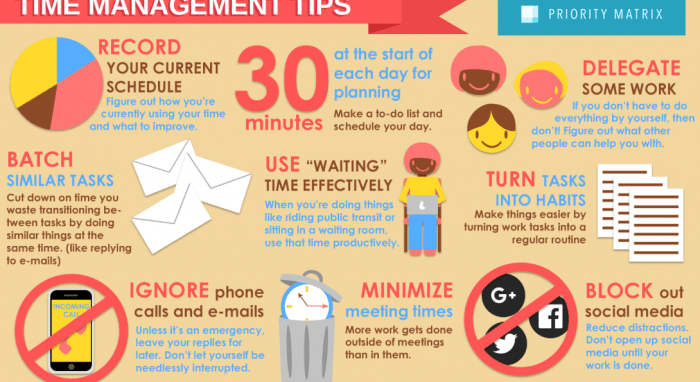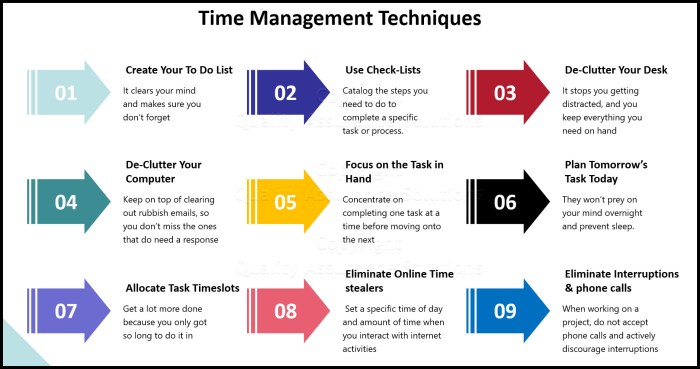Time Management Tips – Get ready to supercharge your productivity and kick stress to the curb with these essential strategies. From prioritization techniques to time blocking strategies, we’ve got you covered with all the tools you need to master your time like a pro.
Introduction to Time Management Tips
Time management is the process of organizing and planning how to divide your time between specific activities. It is essential for maximizing productivity and achieving goals efficiently.
Effective time management is crucial in both personal and professional life as it helps you prioritize tasks, set realistic goals, and make the most out of your day. By managing your time well, you can reduce stress, improve focus, and increase overall productivity.
The Benefits of Good Time Management
- Increased productivity: Proper time management allows you to accomplish more in a shorter amount of time, leading to higher efficiency and output.
- Reduced stress: By planning and organizing your tasks, you can avoid last-minute rushes and minimize stress levels, promoting a sense of control and calmness.
- Improved quality of work: With better time management, you can allocate sufficient time to each task, ensuring better focus and attention to detail, resulting in higher quality work.
- More free time: Efficient time management creates room for leisure activities, hobbies, and personal time, enhancing work-life balance and overall well-being.
Prioritization Techniques

When it comes to managing your time effectively, prioritization is key. By using techniques like the Eisenhower Matrix and setting SMART goals, you can ensure that you focus on what truly matters and make the most out of your day.
The Eisenhower Matrix
The Eisenhower Matrix, also known as the Urgent-Important Matrix, is a powerful tool for prioritizing tasks based on their urgency and importance. It divides tasks into four categories:
- Urgent and Important (Quadrant 1): Tasks that need immediate attention and are crucial to your goals. Handle these tasks first.
- Important but Not Urgent (Quadrant 2): Tasks that are important for your goals but not time-sensitive. Schedule time to work on these tasks to prevent them from becoming urgent.
- Urgent but Not Important (Quadrant 3): Tasks that demand immediate attention but do not contribute much to your goals. Delegate or minimize these tasks whenever possible.
- Not Urgent and Not Important (Quadrant 4): Tasks that are neither urgent nor important. Avoid spending much time on these tasks.
Identifying and Focusing on High-Priority Tasks
Here are some tips to help you identify and focus on high-priority tasks:
- Make a to-do list and rank tasks based on their importance and deadlines.
- Consider the impact of each task on your long-term goals and objectives.
- Use the 80/20 rule (Pareto Principle) to identify tasks that yield the most significant results.
- Regularly review and reassess your priorities to stay focused on what matters most.
Setting SMART Goals to Prioritize Effectively
Setting SMART goals can help you prioritize effectively by making your objectives clear and achievable. SMART goals are Specific, Measurable, Achievable, Relevant, and Time-bound. By setting goals that meet these criteria, you can ensure that you are working towards what truly matters and tracking your progress effectively.
Time Blocking Strategies: Time Management Tips
Time blocking is a time management technique where you divide your day into blocks of time dedicated to specific tasks or activities. By allocating time for each task in advance, you can prioritize effectively and ensure that important tasks are completed. This method helps you focus on one task at a time, minimizes multitasking, and increases productivity.
Creating a Daily or Weekly Schedule, Time Management Tips
To create a daily or weekly schedule using time blocking, follow these steps:
- Start by identifying your most important tasks or priorities for the day or week.
- Allocate specific blocks of time for each task, making sure to include buffer time for unexpected delays.
- Use a planner or digital calendar to map out your schedule visually.
- Color-code your time blocks based on the type of activity (work, personal, exercise, etc.) for easy reference.
Eliminating Distractions
To maximize productivity during time blocks, consider these tips:
- Turn off notifications on your phone or computer to minimize distractions.
- Find a quiet and comfortable workspace where you can focus without interruptions.
- Set specific goals for each time block to stay motivated and on track.
- Use tools like the Pomodoro technique to break your time into intervals with short breaks in between.
Delegation and Outsourcing

Delegating tasks to others and outsourcing certain responsibilities can be key strategies in effective time management. By assigning tasks to others or seeking professional help, you can free up your time to focus on more important or high-priority activities.
Identifying Tasks for Delegation
- Tasks that require specialized skills or knowledge that you lack
- Repetitive or routine tasks that can be easily carried out by someone else
- Tasks that are time-consuming but not necessarily high-value
- Tasks that do not align with your core strengths or interests
Benefits of Outsourcing
- Access to specialized expertise and skills
- Increased efficiency and productivity
- Cost savings in the long run
- Ability to focus on strategic tasks and goals
Technology Tools for Time Management
In today’s digital age, there are numerous technology tools available to help us manage our time more efficiently. From calendars to project management software, these tools can be invaluable in increasing productivity and staying organized.
Popular Time Management Apps and Software
- Todoist: A popular task management app that allows you to create to-do lists, set reminders, and prioritize tasks.
- Google Calendar: An online calendar tool that helps you schedule events, set reminders, and share your schedule with others.
- Trello: A project management tool that uses boards and cards to organize tasks and collaborate with team members.
Benefits of Using Technology for Time Management
- Efficiency: Technology tools can automate repetitive tasks and streamline processes, saving time and effort.
- Organization: Calendars, to-do lists, and project management software help keep tasks and deadlines in one place, reducing the chances of forgetting important activities.
- Collaboration: Tools like Trello and Asana allow teams to work together on projects, assign tasks, and track progress in real-time.
Drawbacks of Relying Solely on Technology
- Distractions: Constant notifications and alerts from technology tools can be distracting and disrupt focus on important tasks.
- Over-reliance: Depending too much on technology for time management can lead to a lack of critical thinking and problem-solving skills.
- Technical Issues: Software glitches or crashes can disrupt workflow and cause delays in completing tasks.





